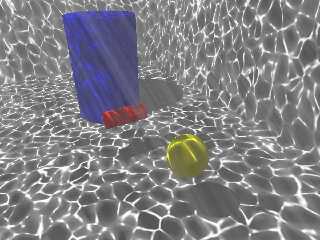|
 |
HelloI would like to extend my scene with the fake caustic to see the light rays
under water. With a scattered media this works, but the computation time
increases indisputably from 0.5 to almost 70s per frame (should become an
animation later).
In the concrete scene the samples have to be at least 50,100 for this to look
usable - so I can't turn the screw anymore.
What possibilities are there to speed up the process (I think that the
calculation time/image should not be more than double or triple, but not by a
factor of 100)?
Is there a way to fake this (similar to what I did with the caustics), but for
the scattering media I have no idea at the moment.
---------------------the scene----------------
// Testscene mit einer gefakten Caustik,
// indem eine helle light_source mit einer Kugel und entspr teiltransparenten
Textur umgeben wird
// Renderzeit: 1sek
#version 3.7;
global_settings {
assumed_gamma 1.0
}
#declare InclMedia = 1;
#declare CausAdd = 0.0;
#declare ScatterCol = 0.0004;
#include "colors.inc"
#include "textures.inc"
#declare PSize = 300;
//////// Caustics-Texture START /////////
#declare TxtS4b =
texture { // "DunkelTextur"
pigment { rgbf <1.0, 1.0, 1.0, 1*CausAdd> }
}
#declare TxtS4a1 =
texture { // "Helltextur"
pigment { color rgbf <1.0, 1.0, 1.0, 1.0> }
finish { diffuse 0.5 ambient 1 }
}
#declare TxtS4a2 =
texture {
pigment { color rgbf <1.0, 1.0, 1.0, 0.2+0.8*CausAdd> }
}
#declare TxtS4c =
bozo
scale 1.5
translate <752,74,62343>
texture_map {
[ 0.25 pigment { rgbf <1.0,1.0,1.0,0.0+CausAdd> } ]
[ 0.5 pigment { rgbf <1.0,1.0,1.0,0.1+0.9*CausAdd> } ]
[ 0.75 pigment { rgbf <1.0,1.0,1.0,0.0+CausAdd> } ]
}
//pigment { color rgbf <0.6, 0.6, 1.0, 1.0> }
}
#declare TxtS4a =
texture { // 1. Layer mit Bozo (Hell-Dunke-Effekte innerbalb der Textur)
bozo
scale 0.5
translate <1223,455,121>
texture_map {
[ 0.15 TxtS4b ]
[ 0.4 TxtS4a2 ]
[ 0.5 TxtS4a1 ]
[ 0.6 TxtS4a2 ]
[ 0.85 TxtS4b ]
}
}
#declare CausticsTxt =
texture { // die eigentliche Caustic-Textur
crackle
turbulence 0.25
omega 0
scale 5
texture_map {
[ 0.0 TxtS4a ]
[ 0.12 TxtS4c ]
[ 0.5 TxtS4b ]
}
scale 0.075
}
//////// Caustics-Texture ENDE /////////
// Boden
difference {
plane { y,0 }
box { <-PSize,-250,-PSize><PSize,1,PSize> } // Pool
pigment { Gray50 }
//pigment { bozo scale 30}
}
//#declare adsasdas =
#ifdef(InclMedia)
box { <-PSize,-250,-PSize><PSize,-50,PSize>
pigment { rgbt 1 } // clear
hollow
interior{
media{
scattering{ 1, ScatterCol extinction 0.01 }
//scattering{ 1, 0.17 extinction 0.01}
samples 50, 100 // min, max
} // end media
} // end interior
}
#end
// #declare adadas =
cylinder {
<-25,0,0><25,0,0> 10
pigment { Red }
translate <100,-200,-50>
}
cylinder {
<0,-300,0><0,100,0> 50
pigment { Blue }
translate <120,-200,70>
}
sphere {
0,20
pigment { Yellow }
translate <120,-200,-150>
}
// Sonne
light_source {
<-50,200, 0>
color 5
}
// Caustics-sphere
#declare CausticsSpr =
sphere {
0,10
texture {
CausticsTxt
translate <clock*0.02 ,clock*0.1, -clock*0.005>
}
}
object {
CausticsSpr
translate <-50,200,0>
}
#declare Cam =
camera {
location 0
direction <0.0, 0.0, 1>
up <0.0, 1.0, 0.0>
right <4/3, 0.0, 0.0>
look_at <0,0,1>
}
camera {
Cam
rotate 30*x
rotate 30*y
translate -70*y
translate -PSize*z+10
}
Post a reply to this message
Attachments:
Download 'lightsource2m1.jpg' (113 KB)
Preview of image 'lightsource2m1.jpg'

|
 |
|
 |
On 6/25/23 17:56, Juergen wrote:
> Hi,
>
> I made a few attempts over the weekend. I followed the variant "transparent
> cylinder". The result looks quite usable, but there are a few restrictions and
> things to consider.
>
> In the core I use a (vertical) cylinder. On this cylinder is a gradient texture
> to avoid sharp edges. Finally, the cylinder is rotated so that it is parallel to
> the light rays.
>
> The constraints are:
> 1. there must be no visible intersection of a cylinder with another object in
> the scene, here you would have sharp, unnatural edges.
> 2. the gradient texture must be aligned with the camera, otherwise the advantage
> of having no sharp edges is lost,
> 3. not too many of these cylinders should be used (about 150), otherwise the
> render time will increase again to the point where you can use the right media.
>
> Jürgen
Hi. It does look like a workable solution.
Real life has me busy these days, but I'll mention a couple additional
things.
Norbert Kern, perhaps a couple years ago (and IIRC), worked out a scheme
where he created a high field containing media (emitting?) in front of
his actual scene for light rays through media effects.
Second and FWIW, when I reworked the fog feature in the povr fork, I
added an 'inverse' feature which creates the densest fog closer to the
camera rather than at greatest depth. The idea is to make it easier to
fake media effects with fog{} using special near-camera, otherwise
invisible/null for ray depth only, shapes. The sad bit is aside from a
few quick experiments, I've never gotten to really playing with the new
feature myself...
Bill P.
Post a reply to this message
|
 |




![]()